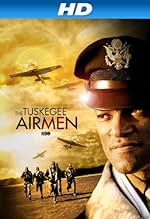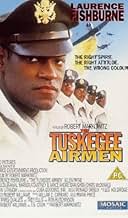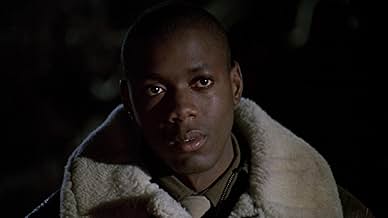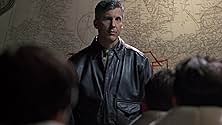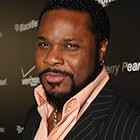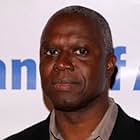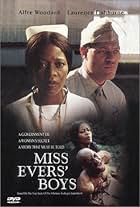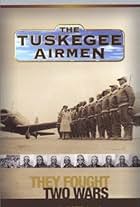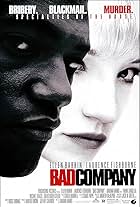IMDb RATING
7.1/10
7.2K
YOUR RATING
The true story of how a group of African-American pilots overcame racist opposition to become one of the finest United States fighter groups in World War II.The true story of how a group of African-American pilots overcame racist opposition to become one of the finest United States fighter groups in World War II.The true story of how a group of African-American pilots overcame racist opposition to become one of the finest United States fighter groups in World War II.
- Won 3 Primetime Emmys
- 6 wins & 16 nominations total
Courtney B. Vance
- Lt. Glenn
- (as Courtney Vance)
Christopher McDonald
- Major Joy
- (as Chris McDonald)
Vivica A. Fox
- Charlene
- (as Vivica Fox)
Storyline
Did you know
- TriviaMost of the characters were fictitious composites of real pilots. However, Benjamin "B.O." Davis was very much a real person and was depicted accurately.
- GoofsWhen Cadet Hannibal Lee is release by Major Joy for his first solo flight, he is given the typical order for all first solo flights: "Three circuits around the [traffic] pattern with full stop landings." The scene then cuts to Cadet Lee far above the traffic pattern altitude (obvious to any pilot) which is a violation of the order he has been given.
- Quotes
[last lines]
Benjamin O. Davis: We weren't assigned. We were requested.
- SoundtracksStraighten Up and Fly Right
Written by Nat 'King' Cole and Irving Mills
Used by permission of EMI Mills Music, Inc. (ASCAP)
Master used by permission of EMI Music Publishing
Featured review
I enjoyed this film a lot, both for the drama and the action. I watched it on the History Channel where scenes from the film were intercut with commentary from surviving Tuskegee airmen. It made the film that much more fascinating.
As one of the other reviewers mentioned, there is one scene where a pilot sinks a German destroyer using only this guns. This is a true event. From the "Tuskegee Airmen" site: "The 332nd Fighter Group also distinguished themselves in June 1944 when two of its pilots flying P-47 Thunderbolt aircraft discovered a German destroyer in the harbor at Trieste, Italy. One of the pilots, Lieutenant Gynne Pierson of the 302nd Fighter Squadron, using only the aircraft's 50-caliber machine guns, strafed the destroyer, causing it to explode and sink."
The statement that the 332nd did not lose a single bomber to enemy action is also true. To qualify that, some of the bombers were lost in other ways, but never to enemy planes. In fact, under Benjamin O. Davis' command, the group flew more than 15,000 sorties against the Luftwaffe, shot down 111 enemy aircraft, and destroyed another 150 on the ground, while losing only 66 of their own aircraft to all causes.
I am not sure they shot down the FIRST German jet, but they did receive a citation after shooting down some German jets. Again, from the TA website: "The 332nd Fighter Group received the Presidential Unit Citation for its longest bomber escort mission to Berlin, Germany, March 24, 1945. They destroyed three German ME-262 jet fighters and damaged five additional jet fighters without losing any of the bombers or any of its own fighter aircraft to enemy aircraft."
Although there were no "aces" that came from the 332nd, this was probably because pilots were told not to pursue German planes for the kill once the planes were far enough away that they no longer posed a danger to the bombers.
The Tuskegee airmen who commented on this film said that the racism they encountered in real life was much worse than was depicted in the film, but much of the rest of the film was realistic.
I found it especially interesting that Benjamin O. Davis, Jr. (played by Andre Braugher) was depicted in this movie. He was a real person who was one of only two black line officers in the U.S. Army at the time--the other was his father. He was one of the first recruits trained at Tuskegee and received his wings in March 1942, after becoming the first black officer to solo an Army Air Corps aircraft. After flying in the Mediterranean, he returned to the US, and took command of the 332d Fighter Group. Eventually, he was awarded the Distinguished Flying Cross. Following the War, he commanded the 477th Composite Group and the 332d Fighter Wing. In 1953 he again saw combat when he assumed command of the 51st Fighter-Interceptor Wing and flew the F-86 in Korea. With his promotion to brigadier general, Davis became the first black man to earn a star in the US Air Force. He retired as a lieutenant general in 1970, and died in 2002, ironically on July 4, at age 89.
As one of the other reviewers mentioned, there is one scene where a pilot sinks a German destroyer using only this guns. This is a true event. From the "Tuskegee Airmen" site: "The 332nd Fighter Group also distinguished themselves in June 1944 when two of its pilots flying P-47 Thunderbolt aircraft discovered a German destroyer in the harbor at Trieste, Italy. One of the pilots, Lieutenant Gynne Pierson of the 302nd Fighter Squadron, using only the aircraft's 50-caliber machine guns, strafed the destroyer, causing it to explode and sink."
The statement that the 332nd did not lose a single bomber to enemy action is also true. To qualify that, some of the bombers were lost in other ways, but never to enemy planes. In fact, under Benjamin O. Davis' command, the group flew more than 15,000 sorties against the Luftwaffe, shot down 111 enemy aircraft, and destroyed another 150 on the ground, while losing only 66 of their own aircraft to all causes.
I am not sure they shot down the FIRST German jet, but they did receive a citation after shooting down some German jets. Again, from the TA website: "The 332nd Fighter Group received the Presidential Unit Citation for its longest bomber escort mission to Berlin, Germany, March 24, 1945. They destroyed three German ME-262 jet fighters and damaged five additional jet fighters without losing any of the bombers or any of its own fighter aircraft to enemy aircraft."
Although there were no "aces" that came from the 332nd, this was probably because pilots were told not to pursue German planes for the kill once the planes were far enough away that they no longer posed a danger to the bombers.
The Tuskegee airmen who commented on this film said that the racism they encountered in real life was much worse than was depicted in the film, but much of the rest of the film was realistic.
I found it especially interesting that Benjamin O. Davis, Jr. (played by Andre Braugher) was depicted in this movie. He was a real person who was one of only two black line officers in the U.S. Army at the time--the other was his father. He was one of the first recruits trained at Tuskegee and received his wings in March 1942, after becoming the first black officer to solo an Army Air Corps aircraft. After flying in the Mediterranean, he returned to the US, and took command of the 332d Fighter Group. Eventually, he was awarded the Distinguished Flying Cross. Following the War, he commanded the 477th Composite Group and the 332d Fighter Wing. In 1953 he again saw combat when he assumed command of the 51st Fighter-Interceptor Wing and flew the F-86 in Korea. With his promotion to brigadier general, Davis became the first black man to earn a star in the US Air Force. He retired as a lieutenant general in 1970, and died in 2002, ironically on July 4, at age 89.
- ruby2andor
- Oct 1, 2004
- Permalink
Details
Box office
- Budget
- $8,500,000 (estimated)
- Runtime1 hour 46 minutes
- Color
- Sound mix
- Aspect ratio
- 1.33 : 1
Contribute to this page
Suggest an edit or add missing content




